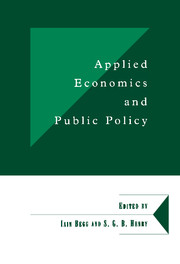Book contents
- Frontmatter
- Contents
- List of figures
- List of tables
- List of contributors
- Foreword
- 1 Introduction
- Part One MODELLING AND FORECASTING METHODS
- Part Two COMBINING DATA AND ANALYTIC TECHNIQUES
- 6 Takeovers, institutional investment and the persistence of profits
- 7 Semi-parametric estimation of the company size–growth relation
- 8 Wage-earnings in Great Britain during the Industrial Revolution
- 9 Company failure and hysteresis
- Part Three USING MODELS TO GUIDE POLICY
- Bibliography
- Index
6 - Takeovers, institutional investment and the persistence of profits
from Part Two - COMBINING DATA AND ANALYTIC TECHNIQUES
Published online by Cambridge University Press: 06 July 2010
- Frontmatter
- Contents
- List of figures
- List of tables
- List of contributors
- Foreword
- 1 Introduction
- Part One MODELLING AND FORECASTING METHODS
- Part Two COMBINING DATA AND ANALYTIC TECHNIQUES
- 6 Takeovers, institutional investment and the persistence of profits
- 7 Semi-parametric estimation of the company size–growth relation
- 8 Wage-earnings in Great Britain during the Industrial Revolution
- 9 Company failure and hysteresis
- Part Three USING MODELS TO GUIDE POLICY
- Bibliography
- Index
Summary
Introduction
This chapter is concerned with the inter-relationship between the shareownership characteristics of companies, their takeover activity and the impact upon them of competitive forces affecting the persistence of their profits. It reflects three strands of work carried out in the DAE since its foundation 50 years ago. The first is the pioneering work on estimating the wealth of the nation by Jack Revell which led, inter alia, to the first systematic analysis of UK shareownership patterns (Revell and Moyle, 1966; Moyle, 1971). The second is the work on company growth, profitability and takeovers making use of the major company panel dataset constructed at the DAE during Brian Reddaway's period as Director (Singh and Whittington, 1968; Singh, 1971; Meeks, 1977; Kumar, 1984; Cosh, Hughes and Singh, 1980). The third is work using the same database on the prediction of profitability by Whittington (1971).
The paper revisits the question of the impact of merger on corporate profitability using UK data for the 1980s. This is familiar territory and is also one of the few areas of economics where there is more or less unanimity of empirical findings. Mergers research from many different countries over diverse time periods has established that mergers normally have a negative or neutral impact on corporate profitability. The present paper brings three new dimensions to the re-examination of this question. Firstly, it is concerned not just with the average impact of mergers, but also with the dispersion of post-merger outcomes.
- Type
- Chapter
- Information
- Applied Economics and Public Policy , pp. 107 - 144Publisher: Cambridge University PressPrint publication year: 1998
- 8
- Cited by

